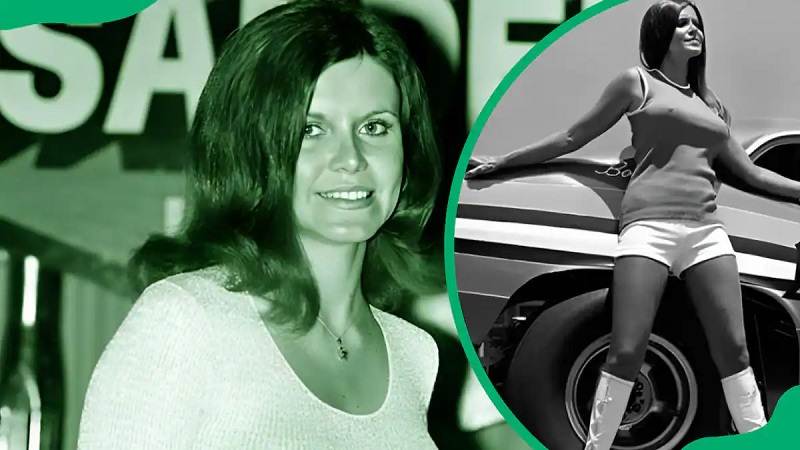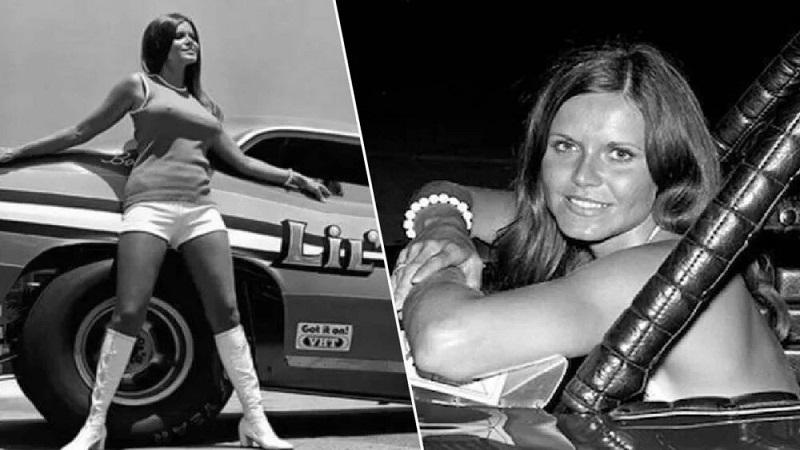In the world of drag racing during the late 1960s and early 1970s, there were few figures as unforgettable as Barbara Roufs. With her radiant smile, towering beauty, and unmatched charisma, she became a beloved symbol of an era defined by roaring engines, fearless drivers, and the electrifying energy of motorsports. But beyond the trophies and flashbulbs, Barbara’s story is also one of mystery, glamour, and tragedy.
This article explores the full life of Barbara Roufs — from her early beginnings to her rise as one of the most celebrated trophy girls in American drag racing, her influence on motorsport culture, and the tragic circumstances surrounding her untimely death.
Early Life and Background
Barbara Roufs was born in the late 1940s in California, USA — a state that would later become the heart of the American drag racing revolution. Growing up in the post-war era, Barbara came of age during a time when American culture was defined by fast cars, Hollywood beauty, and youthful rebellion.
From an early age, Barbara was drawn to the energy and excitement that surrounded California’s car culture. The golden age of automobiles — with chrome, horsepower, and style at its peak — provided the perfect backdrop for a woman who would one day become one of drag racing’s most iconic figures.
Little is known about her early family life, as much of Barbara’s personal history remains private, but her charisma and confidence hinted at a woman destined for the spotlight. She embodied the free-spirited essence of the 1960s and early 1970s — bold, independent, and unafraid to challenge convention.
The Rise of the Drag Racing Culture

To understand Barbara Roufs’ rise to fame, one must first understand the world of drag racing during her era. By the late 1960s, drag racing had become one of the most popular motorsports in America. From professional circuits to small-town strips, thousands of fans gathered every weekend to watch powerful cars burn rubber and drivers push machines to their limits.
This was the era of the “Funny Car” revolution, when drivers and mechanics experimented with outrageous designs and performance upgrades. The sport was evolving rapidly — and along with the drivers and cars, there were the trophy girls — glamorous women who represented the glitz, excitement, and victory of the racing world.
Becoming a Trophy Girl
Barbara Roufs entered the drag racing scene in the early 1970s, quickly capturing attention with her tall frame, long legs, and striking looks. Standing over six feet tall with flowing brown hair and a dazzling smile, she perfectly embodied the ideal of California beauty.
Her entry into the sport came at a time when the image of the trophy girl was being redefined. In earlier decades, trophy girls wore modest outfits and stood beside winners simply as decorative figures. But by the 1970s, the fashion and cultural landscape had shifted — shorter shorts, go-go boots, and bold style choices reflected the new confidence and independence of women.
Barbara embraced this new identity with grace and energy. Her style — short shorts, crop tops, and high boots — mirrored the liberated spirit of the times. She didn’t just hand out trophies; she brought charisma, flair, and a sense of celebration to every event she attended.
The Face of a Racing Era
Barbara Roufs quickly became a fan favorite at NHRA (National Hot Rod Association) events and other California drag strips. She was often seen at major competitions, cheering for drivers, posing for photos, and presenting awards. Her warmth and enthusiasm made her not only admired by fans but also respected within the racing community.
Her popularity skyrocketed in 1970 when she became the “Professional Dragster Association (PDA) Trophy Girl”, one of the most prestigious roles in drag racing at the time. The PDA was a major organization that showcased top-tier dragsters and drivers, and Barbara’s presence helped bring a glamorous edge to the events.
Photographers and racing magazines frequently featured her, cementing her image as a cultural icon of the sport. Her photographs captured the essence of 1970s America — fast cars, sunlit raceways, and the confident beauty of women stepping into public roles once reserved for men.
A Symbol of the 1970s
Barbara Roufs wasn’t just a racing personality; she became a symbol of the changing social climate. The early 1970s were a time of transformation — women were asserting more independence, the fashion world was celebrating freedom and individuality, and popular culture was breaking away from conservative ideals.
Barbara’s image reflected these changes perfectly. She stood at the crossroads of beauty, rebellion, and empowerment. Her confident poses and carefree style challenged traditional notions of femininity and captured the optimism of the decade.
Her photos from the era — many of which resurfaced decades later — continue to fascinate fans and historians alike. They offer a glimpse into a moment in time when motorsport, fashion, and pop culture collided in spectacular form.
Life Beyond the Race Track
While Barbara Roufs’ public persona was full of joy and glamour, little was known about her personal life. Behind the scenes, she was described by friends and colleagues as warm, intelligent, and deeply human.
After her time as a trophy girl, Barbara continued to participate in racing events and modeling work, but like many public figures of her time, she eventually stepped away from the limelight.
She was known to have had a daughter, Jet Roufs, who would later become the key figure in uncovering her mother’s story and bringing her memory back to public attention.
The Mystery and Tragedy of Her Death
Barbara Roufs’ story takes a heartbreaking turn with her untimely death. In 1991, Barbara tragically took her own life at the age of 47. The exact reasons remain private, but her passing shocked those who remembered her for her vibrancy and energy.
Her daughter, Jet Roufs, later spoke publicly about her mother’s life and struggles, expressing love and admiration for the woman behind the glamorous image. In a touching online tribute, Jet revealed that Barbara had been a loving mother, full of kindness and creativity, even as she faced personal battles.
Barbara’s death serves as a poignant reminder that behind every public figure — no matter how glamorous or confident they appear — there are human stories of pain, vulnerability, and complexity.
Rediscovery of Her Legacy
For many years after her death, Barbara Roufs was largely forgotten by the mainstream. Her name was known only among vintage drag racing enthusiasts and those who had attended events during her heyday.
That changed in the 2010s when vintage racing photographer Tom West released a collection of photographs that included stunning images of Barbara from her trophy girl days. The photos, featuring her iconic smile and unmistakable presence, went viral online — reigniting interest in her story.
Fans old and new were captivated. Many younger audiences, unfamiliar with the history of drag racing, discovered Barbara for the first time. The images celebrated her as both a beauty icon and a representation of an era long past — one where motorsport, music, and style intertwined seamlessly.
Cultural Impact and Influence

Barbara Roufs’ impact extended beyond the racetrack. She represented a fusion of sport, glamour, and empowerment that was rare in her time. While drag racing was a male-dominated field, Barbara carved out a place for women to be seen, appreciated, and respected.
In many ways, she helped shape how women were portrayed in motorsports. The trophy girl role, though initially superficial, evolved into a platform where women like Barbara could express individuality, confidence, and personality. She inspired a generation of young women who saw in her the courage to stand out and pursue their passions — even in unconventional fields.
Her influence can still be felt today in how women participate in motorsports, modeling, and entertainment. Modern racing events that feature women as hosts, commentators, and drivers all trace their roots to the pioneering presence of figures like Barbara Roufs.
Remembering Barbara Roufs Today
Today, Barbara Roufs is remembered not only for her beauty and charisma but also for the legacy she left behind. She was more than just a trophy girl — she was a cultural figure who represented a moment of freedom and transformation in American history.
Her daughter, Jet, continues to honor her memory by sharing stories and photos that celebrate who Barbara truly was — a loving mother, a passionate woman, and an unforgettable part of motorsport heritage.
The online racing community often shares vintage photographs of Barbara, keeping her spirit alive among fans who cherish the golden era of drag racing. She has become a nostalgic symbol of an age when cars were fast, music was loud, and life felt boundless.
Lessons from Barbara Roufs’ Life
Barbara Roufs’ life teaches several profound lessons:
- Beauty and strength can coexist. She showed that femininity and confidence were not opposites but complements.
- Cultural icons can shape history in unexpected ways. Through her role, Barbara helped redefine how women were viewed in a male-centric sport.
- Every life has unseen depths. Her tragic passing reminds us to look beyond appearances and understand the human emotions behind fame.
- Legacy transcends time. Decades after her death, Barbara continues to inspire admiration and respect — proof that authentic charm never fades.
Conclusion
Barbara Roufs’ story is both dazzling and heartbreaking — a blend of glory, beauty, and tragedy. As one of the most iconic figures in the history of American drag racing, she brought color and excitement to a sport dominated by speed and competition. Her energy and allure captured the essence of a generation fueled by ambition, freedom, and the pursuit of joy.
Although her life ended too soon, Barbara’s spirit lives on in the photographs, memories, and hearts of those who continue to celebrate her contribution to motorsport culture. She remains an enduring symbol of an era when the world was faster, freer, and full of possibilities — a reminder that even in the fleeting roar of engines, some legends never fade.

